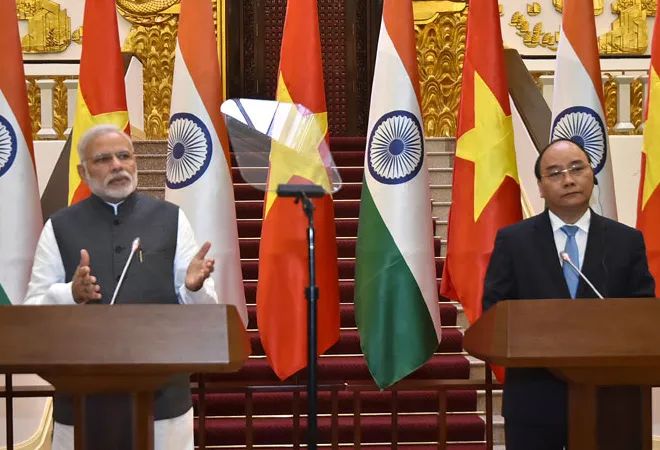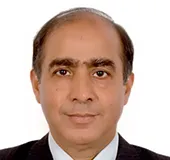
India and Vietnam are thought to have a special relationship built upon a shared history and common interests. Waves of peaceful cultural migration from India, and the discovery of new land and sea routes shaped ties. Does the modern relationship owe itself to history? What are the common interests? Is there sufficient strategic content to the relationship? Do economic links reinforce political ties? Does culture matter?
Vietnam’s close ties to India
According to a
2021 poll by the ISEAS Yusof Ishak Institute, while 50.3 percent of respondents from the ASEAN countries had little to no confidence in India,
31.4 percent of Vietnamese did. After Myanmar, 29.1 percent of Vietnamese had the confidence that India would “do the right thing” to contribute to global peace, security, prosperity, and governance. Overall confidence in India was at
19.8 percent and only 16.5 percent for China.
A Pew Research Centre survey in 2015 found that 66 percent of Vietnamese viewed India favourably, while only 19 percent had a favourable view of China. Fifty six percent of Vietnamese had confidence that Prime Minister Narendra Modi “would do the right thing regarding world affairs,” while only 20 percent had a similar belief in President Xi Jinping. However, such endorsement needs qualification. For example, as India failed to supply the Covishield vaccine that Vietnam had approved in January 2021, Vietnam procured China’s Sinopharm vaccine in June.
As India failed to supply the Covishield vaccine that Vietnam had approved in January 2021, Vietnam procured China’s Sinopharm vaccine in June.
Establishing historical links
“Chinese cultural influence in Vietnam is forceful and potent, while India’s is benign and peaceful,”
<1> says Le Thi Hang Nga from the Institute for Indian and Southwest Asian Studies, Vietnam Academy of Social Sciences. Holding a strategic view of culture, Vietnam allows India’s interventions to offset China’s. The attitude towards the Champa heritage embodied in the Hinduised Champa kingdom is complex, yet pragmatic. Even if the Champas are viewed as foreign intruders, this is not explicitly stated. Nor is the living Cham community, a tiny population of 161,729 people in 2009, a threat to the majority Kinh identity. Thus, a non-threatening Champa legacy becomes a useful elite-level link to India. It serves Vietnam’s China-wary identity politics, while also strengthening ties with India as a welcome partner in preservation of heritage.
After the virtual summit between Prime Ministers Narendra Modi and Nguyen Xuan Phuc on 21 December 2020, a programme of Indian assistance in the preservation of Mỹ Sơn , the Dong Duong Buddhist monastery in Quang Nam, and the Nhan Stupa in Phu Yen was announced. Six sculptures at the
Champa Sculpture Museum in Da Nang figure in Vietnam’s list of national treasures.
<2> Even if ordinary Vietnamese feel no living connection with the Champas, scholars are in the frontlines of cultural assertion. It becomes possible to accommodate a culture without Chinese characteristics.
The attitude towards the Champa heritage embodied in the Hinduised Champa kingdom is complex, yet pragmatic.
For the same reason Vietnam is re-assessing history. The prevailing view is that Vietnam received Buddhism from China. But Nga, quoting research by Le Van Toan, says, “new evidence in Vietnam suggests Indian mariners introduced Buddhism during Ashoka’s reign.”
<3> Having absorbed Chinese intrusion over a millennium, turning history on its head is reassurance, even if Buddhism is not indigenous.
Multiple roadblocks
India is one of only three countries (with Russia and China) with which Vietnam has a Comprehensive Strategic Partnership. Yet, cultural attitudes place India lower in the hierarchy than Vietnam’s most important partners. In the media, creative and disruptive opinions are carefully-controlled. In outlets like
Vietnam News top-down platitudes about the relationship abound. This makes India and Vietnam seem forever allies, but truth is modest. The paradox between strong political ties and weak ground-level measures pushes India down the list. Vietnam sends ministers to national day receptions of major countries, but only vice ministers to India’s national day, though “this is improving,”
<4> Nga says.
The China factor
The Vietnamese understand China better than Indians do, winning by not losing. “The Vietnamese attitude towards China is to cooperate and struggle at the same time,”
<5> Nga asserts. Reena Marwah, a professor at Jesus and Mary College and co-author with Nga of a new book on India-Vietnam ties suggests: “There was barely any reporting on the India-China border standoff since May, 2020. Vietnamese we interviewed said it’s a bilateral issue and declined to comment.”
<6>
If Vietnamese leaders seek India’s support on the South China Sea dispute with China, they should be less reticent on China-India ties, or at least allow free media discussion.
If Vietnamese leaders seek India’s support on the South China Sea dispute with China, they should be less reticent on China-India ties, or at least allow free media discussion. But beyond providing diplomatic and political support, a distant friend (India) lacks the instruments to help Vietnam face present threats from its immediate neighbour, China. The Vietnamese are severely pragmatic in dealing with India and China. Thus, we see symbolic escape acts in creating a picture of close ties. What the comprehensive strategic partnership means is not clear.
Defence partnership
India has strong navy-to-navy co-operation with Vietnam and is one of few countries with which Vietnam conducts naval exercises. Hanoi allows India’s navy to dock in ports,
going beyond Halong Bay, including Nha Trang, which it has asked India to develop, and
Cam Ranh Bay. Under a US $100-million line of credit provided by the Indian government, a High Speed Guard Boat Manufacturing Project has been launched for the Vietnam Border Guard Command.
India handed over the first boat during the 2020 virtual summit between Prime Ministers Modi and Phuc. Two
more Indian- manufactured boats have been launched and seven more will be built in Vietnam.
Such co-operation is a response to China’s grey-zone expansionism in the South China Sea, which directly impinges on Vietnamese and Indian interests. For example, China opposes and obstructs
ONGC Videsh’s oil exploration in Block 128 in Vietnam’s Exclusive Economic Zone in the South China Sea, as it overlaps with China’s self-proclaimed “Nine-Dash Line”. The then
Indian Navy Chief Admiral D.K. Joshi had said that the Indian Navy was prepared to deploy in the South China Sea to protect India’s hydrocarbon interests.
Vietnam and India are aligned in the use of the term Indo-Pacific, a term Hanoi first used in a joint statement with India in 2018.
Vietnam and India are aligned in the use of the term
Indo-Pacific, a term Hanoi first used in a joint statement with India in 2018. Vietnam’s 2019 defence white paper mentioned it: “
Vietnam is ready to participate in security and defense cooperation mechanisms … including security and defense mechanisms in the Indo-Pacific region.” While Vietnam is not a member of QUAD, with China in mind, it hints at validation. “
Any idea or movement that contributes to the peace and stability in the region … should be welcomed,” says Pham Sanh Chau, Vietnam's ambassador to India.
After the announcement of the export of the BrahMos missile to the Philippines, Vietnam is thought to be a potential customer. Despite talks on the sale with the previous UPA government “
little progress was made, due to the UPA’s hesitancy to export defense hardware,” asserts Sylvia Mishra. A negative response from China is believed to have caused India’s hesitation. But the current Indian leadership believes “
stronger defense relationships with the US, Japan, and Vietnam actually put India on stronger footing in its dealings with China,” says Jeff M. Smith. Vietnam might be looking for signs of a change in India’s approach.
Economic factors
AT US $11.1 billion
Vietnam was India’s 10th largest trading partner in 2020- 2021. India is ranked Vietnam’s 26
th highest investor
with an investment of US $1.9 billion. In 2020, Vietnam’s trade with China was
12 times higher at US $133 billion, and China was the largest investor, with US $2.4 billion in November 2020. Indian investments in Vietnam lag behind not just China but also Japan, South Korea, and Singapore. Furthermore, doubt arises from India’s weak economic indicators. For example, in 2020, Vietnam’s per capita GDP was
US $3,525 and India’s was US $1,928. Perceptions of foreign partners are based on ground presence, such as share of imports and investment. If India compares poorly with China and even with Vietnam, it can’t become a credible alternative to China any day soon.
If anything, Vietnam’s ties to China limit its relations with India. As India deepens links with the US, Vietnam seeks to balance its own relations with the US and China. Stronger relations between India and the US makes Vietnam cautious in dealing with India.
Indian investments in Vietnam lag behind not just China but also Japan, South Korea, and Singapore. Furthermore, doubt arises from India’s weak economic indicators.
Indian cultural influence
India’s cultural presence in Vietnam is modest. Rarely are Indian films and television shows broadcast on television channels. Films depicting ancient traditions do not impact the youths and send mixed signals on India’s development.
<7> A survey showed that “70 percent of viewership of the highest-rated Indian show
Balika Vadhu consisted of housewives and elders,”
<8> says Nga. Vietnamese visitors to India are in shock at the miniscule Buddhist community.
Such being the reality, India should be dissuaded from overselling a relationship that undoubtedly has strong foundations but also structural limitations. Vietnam’s commanding location astride the South China Sea places it at the centre of strategic discourse in the region. With multiple claimants to the South China Sea, Vietnam is in a position to broker the many contests and claims surrounding this dispute. With India’s trade and hydrocarbon interests, Vietnam, too, has cards as a regional power to drive favourable bargains with India.
<1> Interview on January 25, 2022.
<2> On December 31, 2020, Prime Minister Nguyen Xuan Phuc signed Decision number 2283/QĐ-TTg recognising national treasures, which includes two statues of Ganesha and Gajasimha, which were added to the list of four sculptures listed as national treasures at the Champa Sculpture Museum, Da Nang.
<3> Interview on January 25, 2022.
<4> Interview on January 25, 2022.
<5> Interview on January 25, 2022.
<6> Interview on January 24, 2022.
<7> Discussion with Marwah and Nga.
<8> Interview on January 25, 2022.
The views expressed above belong to the author(s). ORF research and analyses now available on Telegram! Click here to access our curated content — blogs, longforms and interviews.



 India and Vietnam are thought to have a special relationship built upon a shared history and common interests. Waves of peaceful cultural migration from India, and the discovery of new land and sea routes shaped ties. Does the modern relationship owe itself to history? What are the common interests? Is there sufficient strategic content to the relationship? Do economic links reinforce political ties? Does culture matter?
India and Vietnam are thought to have a special relationship built upon a shared history and common interests. Waves of peaceful cultural migration from India, and the discovery of new land and sea routes shaped ties. Does the modern relationship owe itself to history? What are the common interests? Is there sufficient strategic content to the relationship? Do economic links reinforce political ties? Does culture matter?
 PREV
PREV


